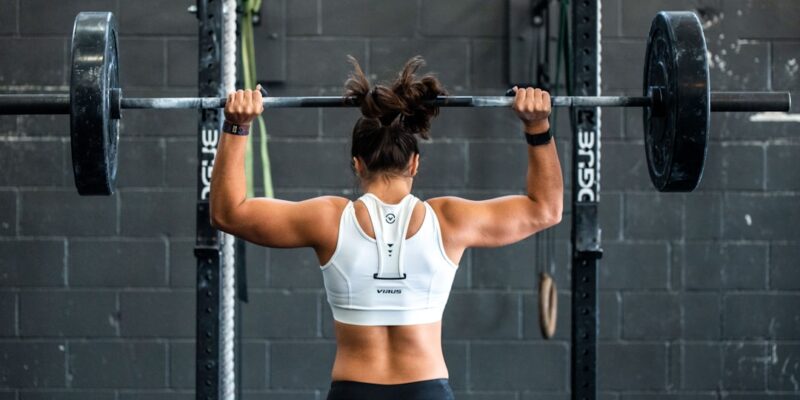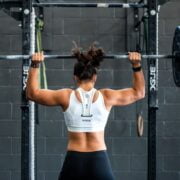
Unlocking the Secret to Stronger Glutes: A Comprehensive Workout Plan with Free PDF Download
Having strong glutes is not just about aesthetics; it is crucial for overall health and fitness. The gluteal muscles, which consist of the gluteus maximus, gluteus medius, and gluteus minimus, play a significant role in our daily activities and athletic performance. Strong glutes can improve posture, enhance athletic performance, prevent injuries, and even alleviate lower back pain.
When it comes to athletic performance, strong glutes are essential for power and explosiveness. They are the primary muscles responsible for hip extension, which is crucial for movements like jumping, sprinting, and lifting heavy weights. Weak glutes can lead to imbalances in the body, increasing the risk of injuries such as knee pain, lower back pain, and hamstring strains.
Key Takeaways
- Strong glutes are important for overall health and fitness.
- Understanding the anatomy of the glutes is crucial for effective training.
- Science-backed glute training can maximize your results.
- The best exercises for stronger glutes include squats, lunges, and hip thrusts.
- A tailored glute workout plan and proper form can help you achieve your best glutes ever.
Anatomy of the Glutes: Understanding Your Muscles
To understand how to train your glutes effectively, it is essential to know the anatomy of these muscles. The gluteal muscles consist of the gluteus maximus, gluteus medius, and gluteus minimus.
The gluteus maximus is the largest muscle in the body and is responsible for hip extension. It helps us stand up from a seated position, climb stairs, and perform explosive movements like jumping and sprinting.
The gluteus medius and gluteus minimus are located on the sides of the hips and are responsible for hip abduction and stabilization. These muscles help maintain balance during activities like walking, running, and changing directions.
Each muscle contributes to overall glute strength and function. Therefore, it is important to target all three muscles when training your glutes.
The Science Behind Glute Training: How to Maximize Your Results
To maximize your results when training your glutes, it is important to understand the principles of progressive overload. Progressive overload refers to gradually increasing the demands placed on your muscles to stimulate growth and strength gains. This can be achieved by increasing the weight, reps, or sets of your exercises over time.
Proper form and technique are also crucial for maximizing results and preventing injuries. When performing glute exercises, it is important to maintain proper alignment, engage the glutes throughout the movement, and avoid compensating with other muscles. This can be achieved by focusing on mind-muscle connection and performing exercises with controlled movements.
Incorporating different types of exercises into your glute training routine is also beneficial. Compound exercises like squats and deadlifts target multiple muscle groups, including the glutes, while isolation exercises like hip thrusts and glute bridges specifically target the gluteal muscles. By incorporating a combination of compound and isolation exercises, you can ensure that you are targeting all aspects of your glutes for optimal results.
The Best Exercises for Stronger Glutes: A Step-by-Step Guide
| Exercise | Description | Repetitions | Sets | Rest Time |
|---|---|---|---|---|
| Barbell Hip Thrust | Place your upper back on a bench and sit on the floor with a barbell over your hips. Drive your hips up towards the ceiling, squeezing your glutes at the top. | 8-12 | 3-4 | 60-90 seconds |
| Deadlift | Stand with your feet hip-width apart and a barbell in front of you. Hinge at the hips and lower the barbell towards the ground, keeping your back straight. Drive through your heels to stand back up. | 8-10 | 3-4 | 60-90 seconds |
| Glute Bridge | Lie on your back with your knees bent and feet flat on the ground. Drive your hips up towards the ceiling, squeezing your glutes at the top. | 12-15 | 3-4 | 30-60 seconds |
| Single-Leg Deadlift | Stand on one leg with a dumbbell in the opposite hand. Hinge at the hips and lower the dumbbell towards the ground, keeping your back straight. Drive through your heel to stand back up. | 8-10 per leg | 3-4 | 60-90 seconds |
| Step-Up | Stand in front of a bench or step with a dumbbell in each hand. Step up onto the bench with one foot, driving through your heel. Step back down and repeat on the other side. | 10-12 per leg | 3-4 | 60-90 seconds |
There are several exercises that are highly effective for building strong glutes. Here are some of the best exercises along with step-by-step instructions:
1. Squats: Stand with your feet shoulder-width apart, toes slightly turned out. Lower your body down as if sitting back into a chair, keeping your chest up and knees tracking over your toes. Push through your heels to return to the starting position.
2. Deadlifts: Stand with your feet hip-width apart, holding a barbell or dumbbells in front of your thighs. Hinge at the hips, keeping your back straight, and lower the weight down towards the ground. Push through your heels to return to the starting position.
3. Hip Thrusts: Sit on the ground with your upper back against a bench or elevated surface. Place a barbell or weight across your hips. Drive through your heels to lift your hips off the ground until your body forms a straight line from your knees to your shoulders. Lower your hips back down and repeat.
4. Glute Bridges: Lie on your back with your knees bent and feet flat on the ground. Drive through your heels to lift your hips off the ground until your body forms a straight line from your knees to your shoulders. Lower your hips back down and repeat.
5. Lunges: Stand with your feet hip-width apart. Take a step forward with one foot and lower your body down until both knees are bent at a 90-degree angle. Push through your front heel to return to the starting position and repeat on the other side.
These exercises can be modified for beginners by using lighter weights or bodyweight only. For advanced lifters, you can increase the weight or add resistance bands to make the exercises more challenging.
The Perfect Glute Workout Plan: Tailored to Your Fitness Level
Here is a sample glute workout plan that can be tailored to different fitness levels:
Beginner Workout:
– Squats: 3 sets of 10 reps
– Glute Bridges: 3 sets of 12 reps
– Lunges: 3 sets of 10 reps per leg
– Rest for 60 seconds between sets
Intermediate Workout:
– Squats: 4 sets of 8 reps
– Deadlifts: 4 sets of 8 reps
– Hip Thrusts: 4 sets of 10 reps
– Rest for 45 seconds between sets
Advanced Workout:
– Squats: 5 sets of 6 reps
– Deadlifts: 5 sets of 6 reps
– Hip Thrusts: 5 sets of 8 reps
– Lunges: 5 sets of 6 reps per leg
– Rest for 30 seconds between sets
Perform this workout plan two to three times per week, allowing at least one day of rest between sessions. As you progress, gradually increase the weight or resistance to continue challenging your glutes.
Tips for Proper Form and Technique: Avoiding Common Mistakes
When performing glute exercises, it is important to avoid common mistakes that can compromise your form and technique. Here are some tips to help you maintain proper form:
– Keep your chest up and shoulders back to maintain a neutral spine.
– Engage your core muscles throughout the movement to stabilize your body.
– Avoid rounding your lower back or arching excessively.
– Focus on squeezing your glutes at the top of each movement.
– Use a controlled tempo and avoid using momentum to complete the exercise.
– Start with lighter weights or bodyweight only to ensure proper form before progressing to heavier weights.
By following these tips, you can avoid injury and maximize the effectiveness of your glute training.
Incorporating Cardio into Your Glute Training: The Benefits and Best Practices
Incorporating cardio exercises into your glute training routine can provide additional benefits for overall fitness and glute development. Cardio exercises that target the glutes include running, cycling, stair climbing, and jumping rope.
Cardio exercises help improve cardiovascular endurance, burn calories, and increase overall fitness levels. They also provide an opportunity to engage the gluteal muscles in a different way, promoting muscle growth and strength.
To incorporate cardio into your glute training routine, you can perform cardio exercises on separate days or after your strength training workouts. Aim for at least 150 minutes of moderate-intensity cardio or 75 minutes of vigorous-intensity cardio per week for optimal health benefits.
Nutrition for Glute Growth: Fueling Your Body for Success
Proper nutrition is essential for building strong glutes. To support muscle growth and recovery, it is important to consume an adequate amount of calories and macronutrients.
Protein is particularly important for muscle growth. Aim to consume 0.8-1 gram of protein per pound of body weight per day. Good sources of protein include lean meats, poultry, fish, eggs, dairy products, legumes, and plant-based protein sources like tofu and tempeh.
Carbohydrates provide energy for your workouts and help replenish glycogen stores in your muscles. Include complex carbohydrates like whole grains, fruits, vegetables, and legumes in your diet.
Healthy fats are also important for hormone production and overall health. Include sources of healthy fats like avocados, nuts, seeds, olive oil, and fatty fish in your diet.
Hydration is also crucial for muscle function and recovery. Aim to drink at least 8 cups (64 ounces) of water per day, or more if you are active or live in a hot climate.
Tracking Your Progress: How to Monitor Your Glute Strength
Tracking your progress is important when training your glutes to ensure that you are making progress and reaching your goals. Here are some ways to monitor your glute strength:
– Take measurements: Measure the circumference of your glutes using a tape measure. Take measurements at regular intervals, such as every four weeks, to track changes in size.
– Progress photos: Take photos of your glutes from different angles to visually track changes in muscle definition and shape.
– Strength gains: Keep a record of the weights you use for each exercise and track any increases over time. This will help you see improvements in strength and track progress.
– Performance improvements: Pay attention to how your glutes feel during daily activities and workouts. Notice if you feel stronger or more stable during movements that involve the glutes.
By tracking your progress, you can stay motivated and make adjustments to your training plan as needed.
Achieving Your Best Glutes Ever with This Comprehensive Workout Plan
In conclusion, having strong glutes is important for overall health and fitness. Strong glutes can improve athletic performance, prevent injuries, and enhance daily activities. By understanding the anatomy of the glutes, incorporating the principles of progressive overload, and following a comprehensive workout plan, you can achieve your best glutes ever.
Remember to focus on proper form and technique, incorporate a variety of exercises, and track your progress to ensure that you are making gains. With dedication, consistency, and the right nutrition, you can build strong and powerful glutes that will support you in all aspects of your life. So, get started on this comprehensive workout plan and watch your glutes transform!
Looking for a comprehensive glute building workout plan? Look no further! Check out this amazing glute-building workout plan PDF from Wave Magnets. But that’s not all, Wave Magnets also offers a variety of other fitness resources and articles to help you achieve your fitness goals. One article that caught my attention is their guide on “The Importance of Proper Form in Strength Training.” It provides valuable insights and tips on how to perform exercises correctly to maximize results and prevent injuries. Don’t miss out on this informative read, click here to check it out: The Importance of Proper Form in Strength Training.
FAQs
What is a glute building workout plan?
A glute building workout plan is a set of exercises designed to target and strengthen the gluteal muscles, also known as the buttocks.
Why is it important to have a glute building workout plan?
Having a glute building workout plan can help improve overall lower body strength, increase muscle mass, and improve athletic performance. It can also help improve posture and reduce the risk of injury.
What exercises are typically included in a glute building workout plan?
Exercises that are typically included in a glute building workout plan include squats, lunges, deadlifts, hip thrusts, and glute bridges.
How often should I do a glute building workout plan?
It is recommended to do a glute building workout plan 2-3 times per week, with at least one day of rest in between each workout.
How long does it take to see results from a glute building workout plan?
Results can vary depending on individual factors such as genetics, diet, and consistency with the workout plan. However, it is generally recommended to give it at least 4-6 weeks to start seeing noticeable results.
Can I do a glute building workout plan at home?
Yes, many glute building exercises can be done at home with little to no equipment. However, it is important to ensure proper form and technique to avoid injury.


















